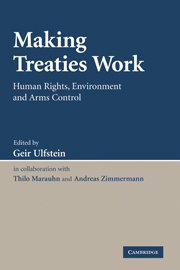Book contents
- Frontmatter
- Contents
- Preface and acknowledgments
- Notes on the contributors
- Table of cases
- Table of treaties and other international instruments
- INTRODUCTION
- PART I INTERNATIONAL HUMAN RIGHTS
- PART II INTERNATIONAL ENVIRONMENTAL LAW
- PART III INTERNATIONAL ARMS CONTROL
- 10 Dispute resolution, compliance control and enforcement of international arms control law
- 11 The Convention on the Prohibition of the Development, Production, Stockpiling and Use of Chemical Weapons and on their Destruction (Chemical Weapons Convention)
- 12 The Treaty on the Non-Proliferation of Nuclear Weapons (NPT) and the IAEA Safeguards Agreements
- 13 The Convention on the Prohibition of the Use, Stockpiling, Production and Transfer of Anti-Personnel Mines and on their Destruction (Ottawa Convention)
- GENERAL COMMENTS
- Index
10 - Dispute resolution, compliance control and enforcement of international arms control law
Published online by Cambridge University Press: 05 September 2009
- Frontmatter
- Contents
- Preface and acknowledgments
- Notes on the contributors
- Table of cases
- Table of treaties and other international instruments
- INTRODUCTION
- PART I INTERNATIONAL HUMAN RIGHTS
- PART II INTERNATIONAL ENVIRONMENTAL LAW
- PART III INTERNATIONAL ARMS CONTROL
- 10 Dispute resolution, compliance control and enforcement of international arms control law
- 11 The Convention on the Prohibition of the Development, Production, Stockpiling and Use of Chemical Weapons and on their Destruction (Chemical Weapons Convention)
- 12 The Treaty on the Non-Proliferation of Nuclear Weapons (NPT) and the IAEA Safeguards Agreements
- 13 The Convention on the Prohibition of the Use, Stockpiling, Production and Transfer of Anti-Personnel Mines and on their Destruction (Ottawa Convention)
- GENERAL COMMENTS
- Index
Summary
Introduction
Arms control and disarmament can best be understood as processes, both in substance and over time. The initiation of such processes necessitates a favourable political climate among participating States, facilitating communication among them and allowing the preparation of (treaty) negotiations. In order to successfully conduct such negotiations, it is important to define precisely their substance, i.e. the problem to be solved and the objective to be achieved. Traditionally, States have been concerned primarily with the prevention of armed conflict, the establishment of international security and the limitation of damage in case of conflict. Increasingly, however, economic considerations – i.e. restricting armaments expenditure – and confidence-building have become important, enhancing cooperation among States. In light of the complexity of arms control negotiations, States often first agree upon their general set-up, issuing political declarations of intent. Such political agreements indicate the perception of States ‘that their individual national security is better served if the arms competition between them is managed under agreed covenants’. Since the mid-1980s, such processes have eventually led to the conclusion of multilateral arms control agreements, illustrating a ‘clearly discernible trend towards greater legalism in arms control’.
While the general public often perceives the conclusion of such arms control agreements as the final outcome of the political process, it may be argued that the entry into force of any arms control and disarmament treaty must be considered to be the beginning rather than the end of the matter.
- Type
- Chapter
- Information
- Making Treaties WorkHuman Rights, Environment and Arms Control, pp. 243 - 272Publisher: Cambridge University PressPrint publication year: 2007
- 3
- Cited by



